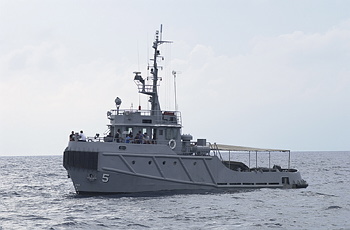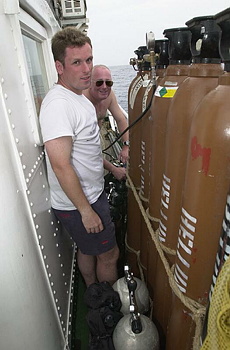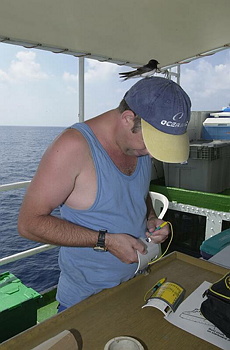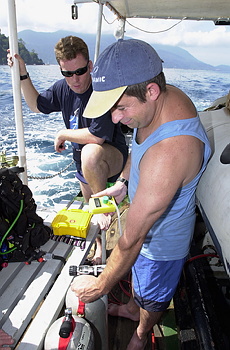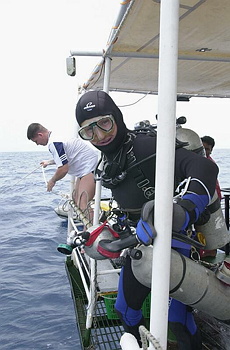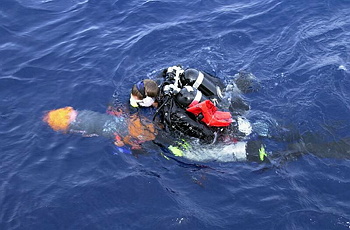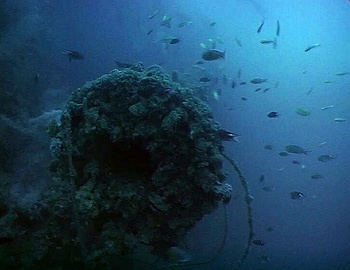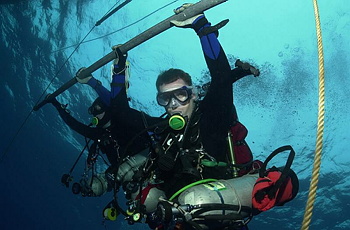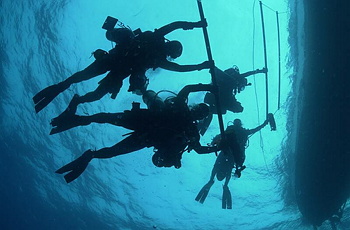19 SEPTEMBER
2001
The sense of confident optimism over the breakfast table was soon lost as it became clear that the crew were having difficulty recovering the anchor. Closer inspection revealed that the anchor chain (almost 100m of it) was slipping off the drum of the winch. Dave Taylor put his years as a commercial fisherman (prior to joining the Para's) to good use and got the crew to attach a thick rope to the chain as far down as they could. The rope was attached to the outside section on the drum and using a combination of rope and chain (and all hands to the pump!) we managed to take in the slack in the chain. With the slack taken in however, the anchor would still not budge. The Malaysian Navy (who had been hovering nearby for the last few days) came alongside and offered to give us a hand. This seemed to inspire the boat crew who would not accept defeat. The chief locked off the chain, stripped down the winch and fitted another cog in what seemed like only a few minutes. Slowly but surely the chain came up. Despite it occasionally slipping it was obvious that the task was in hand, the Malaysian offer was politely declined and preparation for the days diving resumed.
Time had been marching by and the priority was on getting divers (especially those not on scooters) in the water. A shot was dropped right on top of the Prince of Wales and Davy, Stu and Paul scootered down to double check it was on the wreck. A bag broke surface after a couple of minutes confirming that this was the case and the remainder of the divers were dispatched. The current was still on slack and they swam down to the wreck at a good pace before heading down the hull to the stern to explore the huge props. Rod and Dan scootered down to the wreck hot on their heals trying to fit together the few last few pieces of the jig-saw of this great ship's final moments.
Although the plan had been to survey the port side of the stern - where the first wave torpedoes had struck - as soon as they reached the wreck it became clear that in fact the shot had been dropped some 50 feet away from the very bow. Dropping down to the seabed at 70msw Dan took some moody video footage under the upturned main deck through the trawl nets draped over the bow, to the clear green water on the other side of the vessel.
Rising up from the seabed along the very bow itself Dan & Rod soon came to a large torpedo hole just beneath the waterline - the explosion had torn clean through to the other side of the hull leaving a huge gaping tear in the bow. Where the torpedo had struck on the starboard side the plates here were all bent inwards. On the port side, the explosion had blown outwards leaving plating peeled back as though opened with a can opener.
After taking some more video here Dan & Rod knew that if they were going to check out the stern port side on this final dive they now had to scooter the full 745 feet of the ship to get there - and that against the prevailing current. So it was full throttle, head down and into as streamlined a position as possible for the tour down the hull.
As they approached the stern the sweep of the hull revealed the thick
armour belt projecting from the hull. Suddenly they were at the port side
propeller shaft and immediately behind it they found a 25 foot wide torpedo
hole - this was the first hit on the port side during the first wave of
the attack. The propeller tunnel projected out for some 15 feet but then
came to a sudden halt at a flange bracket - the main section of the shaft
and the prop itself were no longer on the wreck. Peering up the prop tunnel
it was clear that the tunnel was empty of its shaft - so it would appear
that the prop shaft had not been blown or cut through and salvaged.
Looking at the damage in this area it was easy to visualise what had happened
during this catastrophic first attack. A lucky strike here right at the
port side outboard prop had blown the hull open and caused all sorts of
internal problems as the 250 foot long shaft was bent and then as it continued
to turn, vibrated and shook itself loose. If the torpedo had struck just
20 feet away on the armour belt then the ship would have been far greatly
protected and may not in the end have sunk.
The hull plating around the prop shaft had been bent outwards and contorted
by the thrashing of the prop shaft. The prop itself and a large section
of the shaft had probably come off and dropped to the seabed at some stage
of the battle. This damage probably explained why the top half of one
of the inboard port prop blades was missing - it was possibly hit by debris
from the first explosion - or possibly by the outboard prop and shaft
itself as it worked itself into increasingly wider arcs before falling
to the seabed.
All too soon the allotted bottom time was spent and it was time for the
long ascent to the surface where they joined the other team of Doc Adey,
Martin and Greg on the deco trapeze.
As soon as all the divers were out of the water and a replacement supervisor was on board, Dave and Guy leapt over the side of the boat desperate to make the dive before the current became too strong. At 30m the wreck was clearly visible. The pair left the shot line and scootered to the bottom. Visibility soon reduced to approximately 10-15m. Now familiar with the wreck they headed aft passing over both 5.25 inch anti-aircraft guns and pausing to look at the commemorative plaque. Guy stopped to study the upturned base of what appeared to be the lower section of the higher twin 5.25 inch anti-aircraft gun, the main turret body now buried in the sand. After scootering around it and locating what looked like the entrance way they headed for the stern before heading up to look at the propellers. Despite the visibility the props were clearly visible. After finding three, a more detailed search for the fourth was conducted. After a short while the broken A bracket, designed to hold the prop shaft in place, was found as well as the flange where the prop and last few meters of prop shaft should have been bolted in place. Had the prop been blown off during the action or had salvers removed it? A later study off the video shot by Dan would reveal all! With the clock running down the two reluctantly left the wreck. Not wanting to go they scootered back and forth for one last look making the most of the time at the deeper stops. With no shot line to be seen and sight of the wreck gone it was time to put a bag up. The minutes dragged by as both divers craved to sit down, recount what they had seen and try to piece together the mystery of the missing fourth prop.
Once all the divers were back on-board they crammed into the galley for a de-brief and to watch the video footage for that day on the last days diving on the Prince of Wales. Diving finished for the day the MV Mata Ikan headed for Tioman Island for a well-deserved night out and day off!
